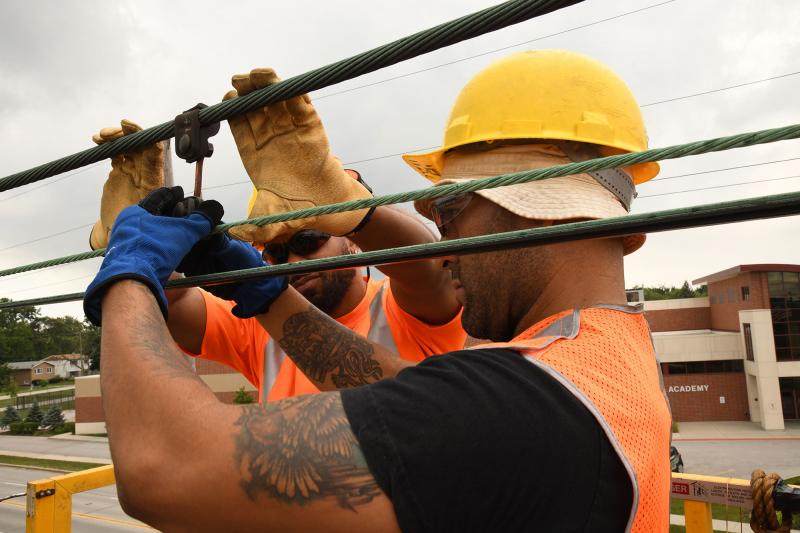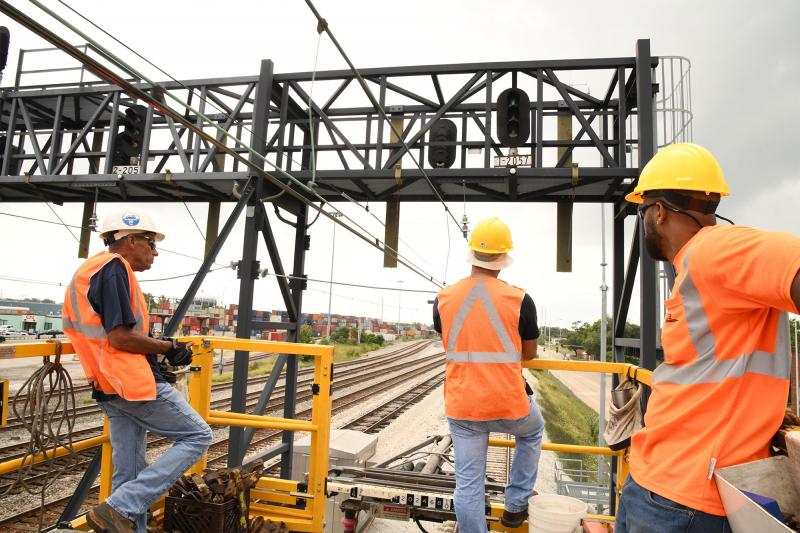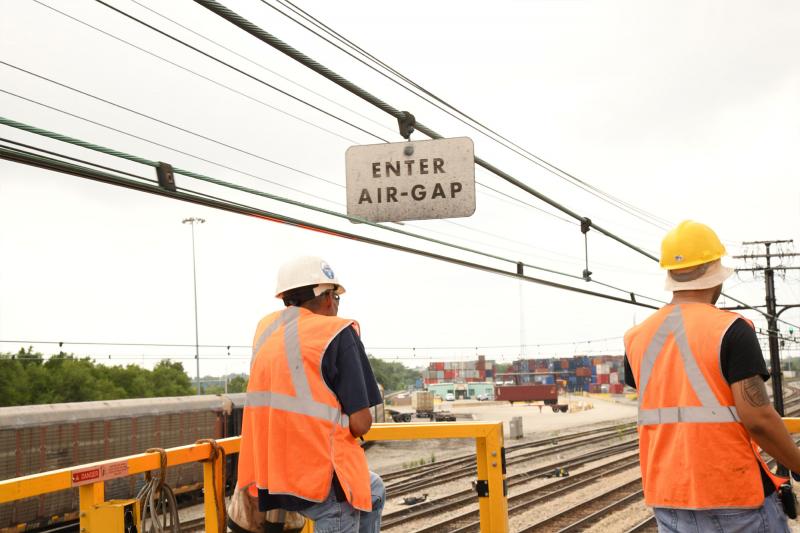Dark clouds form over a group of Metra electricians as they duck to avoid striking their heads against an overhead wire system pulsing with 1500 volts of electricity.
 They’re riding 14 feet above the train tracks on top of a catenary maintenance vehicle, a specialized piece of equipment used to inspect the overhead wires along the Metra Electric Line. Just outside Homewood, they spot something amiss, ask the electrician driving to stop the vehicle, and grab the wire.
They’re riding 14 feet above the train tracks on top of a catenary maintenance vehicle, a specialized piece of equipment used to inspect the overhead wires along the Metra Electric Line. Just outside Homewood, they spot something amiss, ask the electrician driving to stop the vehicle, and grab the wire.
A hanger, a metal rod that connects the auxiliary and main catenary wires, needs to be replaced. One electrician grabs a custom-made wrench to remove the hanger and the clips that connect it to the wires. Two then team up to cut a new hanger, connect it to new clips, and use the same specialized wrench to secure the hanger.
Rain starts to fall, leaving dark spots on their fluorescent orange vests. They radio to the engineer to roll on.
A workshop on wheels, the catenary maintenance vehicle enables Metra’s direct current (DC) electricians to maintain and repair the electric cables that power trains on the Metra Electric Line in a fraction of the time it would take otherwise.
“Anything we find when we’re out here, we fix,” said Markell Parks, the lead DC electrician for the DC Department on the Metra Electric District. “The other option is to be in a truck driving along the tracks and looking. Then you have to find a place to park, pull ladders off, and walk. The catenary car is so much easier to use because we can get right to everything.”
Unlike the rest of the equipment running on the Metra Electric Line, the catenary maintenance vehicle, also known as the tower car, is diesel-powered. The self-propelled car typically goes no faster than 20 mph during an inspection.
 Electricians stand on an insulated platform that allows them to work on the live wires, and the car also has a pantograph that acts as a rolling ground switch. Ideally, a crew will consist of six DC electricians, including one who operates the vehicle from either inside the vehicle or on top of the platform with the rest of the crew. Metra’s DC electricians, under the guidance of Supervisor Ed Schafroth and Assistant Supervisor Dan Deneen, are responsible for maintaining the catenary system, including the feeder cables to electric substations, while alternating current (AC) electricians are responsible for the power to platforms, lights, ticket machines and heating and cooling systems.
Electricians stand on an insulated platform that allows them to work on the live wires, and the car also has a pantograph that acts as a rolling ground switch. Ideally, a crew will consist of six DC electricians, including one who operates the vehicle from either inside the vehicle or on top of the platform with the rest of the crew. Metra’s DC electricians, under the guidance of Supervisor Ed Schafroth and Assistant Supervisor Dan Deneen, are responsible for maintaining the catenary system, including the feeder cables to electric substations, while alternating current (AC) electricians are responsible for the power to platforms, lights, ticket machines and heating and cooling systems.
The platform swivels 90 degrees in either direction and can be raised up to 20 feet in order for electricians to get as close to the wires as needed.
Electricians come equipped to replace clips, hangers and entire stretches of cable. Each reel of wire contains about one mile’s worth of material, and the tower car can carry up to three reels. Electricians carry micrometers to measure the thickness of the contact wire (the lowest in the catenary system that makes contact with the pantograph) to determine if any sections need to be replaced.
 The crew pays special attention to areas known as air gaps, the end of one section of catenary wire and the beginning of another, and interlockings, where trains can pass from one track to another, to make sure each train’s pantograph moves smoothly and stays on the wire.
The crew pays special attention to areas known as air gaps, the end of one section of catenary wire and the beginning of another, and interlockings, where trains can pass from one track to another, to make sure each train’s pantograph moves smoothly and stays on the wire.
Crews work in any weather except lightning and try to concentrate their work during times when it won’t interrupt service.
“Sunday is the big work day,” Parks said. “And a lot of work is done during the colder months.”
Crews use the tower car to perform inspections several times a month. Their goal, like that of other Metra departments, is to ensure customers get to their destinations safely and on time. It’s a group effort, Parks said. It seems to be working. The Metra Electric Line had an on-time performance rate of 98.6 percent in August, the best on-time performance rate of any of Metra’s lines.